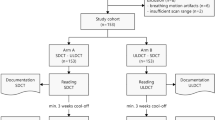Abstract
Recently, a new method for acquiring SPECT data in deep inspiratory breath hold with a high-speed rotation (HSR-SPECT) technique was developed for pulmonary perfusion scintigraphy. Our purpose in this study was to apply this method to hepatic-function scintigraphy. A phantom study was performed for determining data acquisition times. The coefficient of variation (CV) value was used for evaluating nonuniformity of radioactivity in the liver area. Data acquisition times were determined based on the CV value. According to the results of the phantom study, this method needs at least ten projection data sets for acquiring sufficient counts for a proper diagnosis. Under clinical conditions, breath-holding HSR-SPECT can suppress the respiratory motion effects, better than the conventional method can. In addition, the fusion images made from breath-holding HSR-SPECT images match excellently with CT images.




Similar content being viewed by others
References
Oishi Y, Iwanaga H, Suga K, Ide R, Shimizu A, Inoue A, et al. Examination of three-detector high-speed-rotation SPECT acquisition under breathhold in body: clinical application of 99mTc-MAA. Jpn J Radiol Technol. 2006;62:281–8.
Iwanaga H, Oishi Y, Suga K. Development of a new method of high-speed rotation multiplied projection single photon emission computed tomography of the triple-headed type: lung MAA SPECT based on phantom study. Jpn J Radiol Technol. 2006;62:848–54.
Suga K, Yasuhiko K, Iwanaga H, Hayashi N, Yamashita T, Matsunaga N. Enhanced perfusion defect clarity and inhomogeneity in smokers’ lungs with deep-inspiratory breath-hold perfusion SPECT images. Nucl Med Commun. 2005;26:801–7.
Suga K, Yasuhiko K, Iwanaga H, Tokuda O, Matsunaga N. Relation between lung perfusion defects and intravascular clots in acute pulmonary thromboaembolism: Assessment with breath-hold SPECT-CT pulmonary angiography fusion images. Eur J Radiol. 2007 (Sep 28). doi:10.1016/j.ejrad.2007.08.023.
Harris B, Bailey D, Roach P, Bailey E, King G. Fusion imaging of computed tomographic pulmonary angiography and SPECT ventilation/perfusion scintigraphy initial experience and potential benefit. Eur J Nucl Med Mol Imaging. 2007;341:135–42.
Suga K, Yasuhiko K, Iwanaga H, Tokuda O, Matsunaga N. Automated breath-hold perfusion SPECT/CT fusion images of the lungs. AJR Am J Roentgenol. 2007;189(6):455–63.
Murakawa K, Katafuchi T, Nishimura Y, Enomoto N, Sago M, Oka H. Usefulness of attenuation correction with transmission source in myocardial SPECT. Jpn J Radiol Technol. 2006;62:70–7.
Hayashi M, et al. Attenuation correction by X-ray CT using deep breath-hold SPECT (BrST) method. Jpn SNMT. 2006;26:185–93.
Acknowledgment
The authors thank Mr. Shouhei Kudomi, Mr. Steven Gardner and Mr. Tizo Sanada for their help in the preparation of this manuscript. We are also indebted to Nihon Medi-Physics for allowing us to apply the liver and kidney phantom (Kyotokagaku Co.,Ltd, Kyoto, Japan). We are grateful to the reviewers and editors for many useful comments and suggestions for improving this manuscript.
Author information
Authors and Affiliations
Corresponding author
About this article
Cite this article
Yonezawa, T., Koike, M., Oishi, Y. et al. Application of breath-holding SPECT with high-speed-rotation technique in hepatic-function scintigraphy. Radiol Phys Technol 1, 234–237 (2008). https://doi.org/10.1007/s12194-008-0034-1
Received:
Revised:
Accepted:
Published:
Issue Date:
DOI: https://doi.org/10.1007/s12194-008-0034-1




